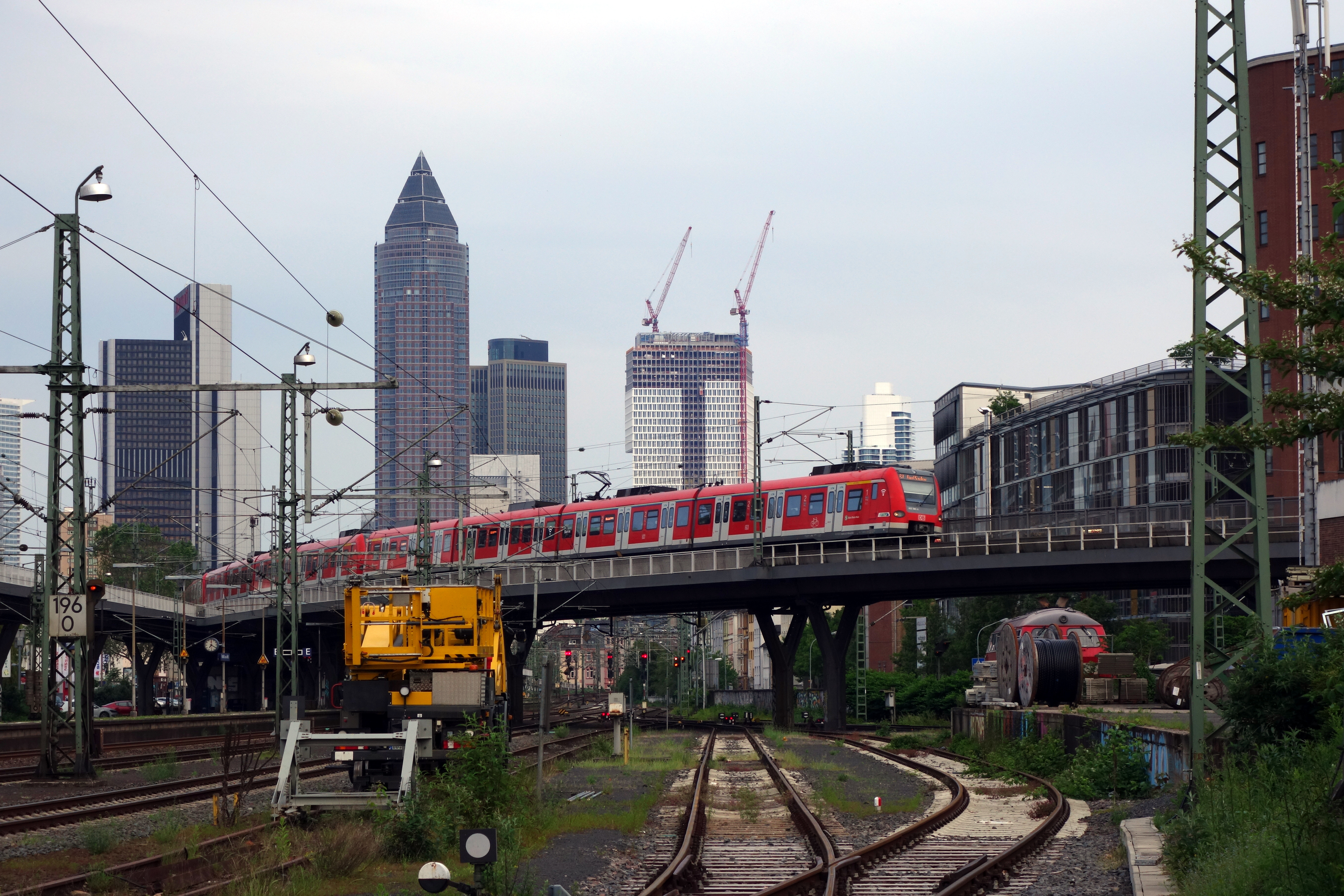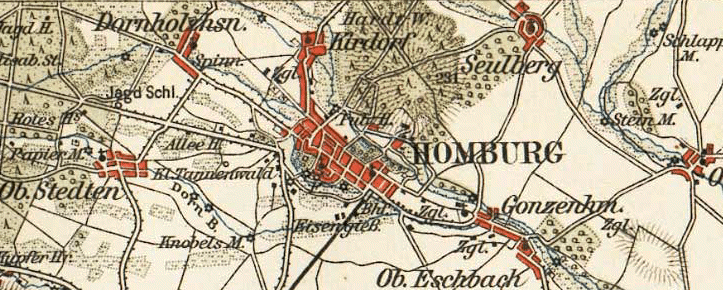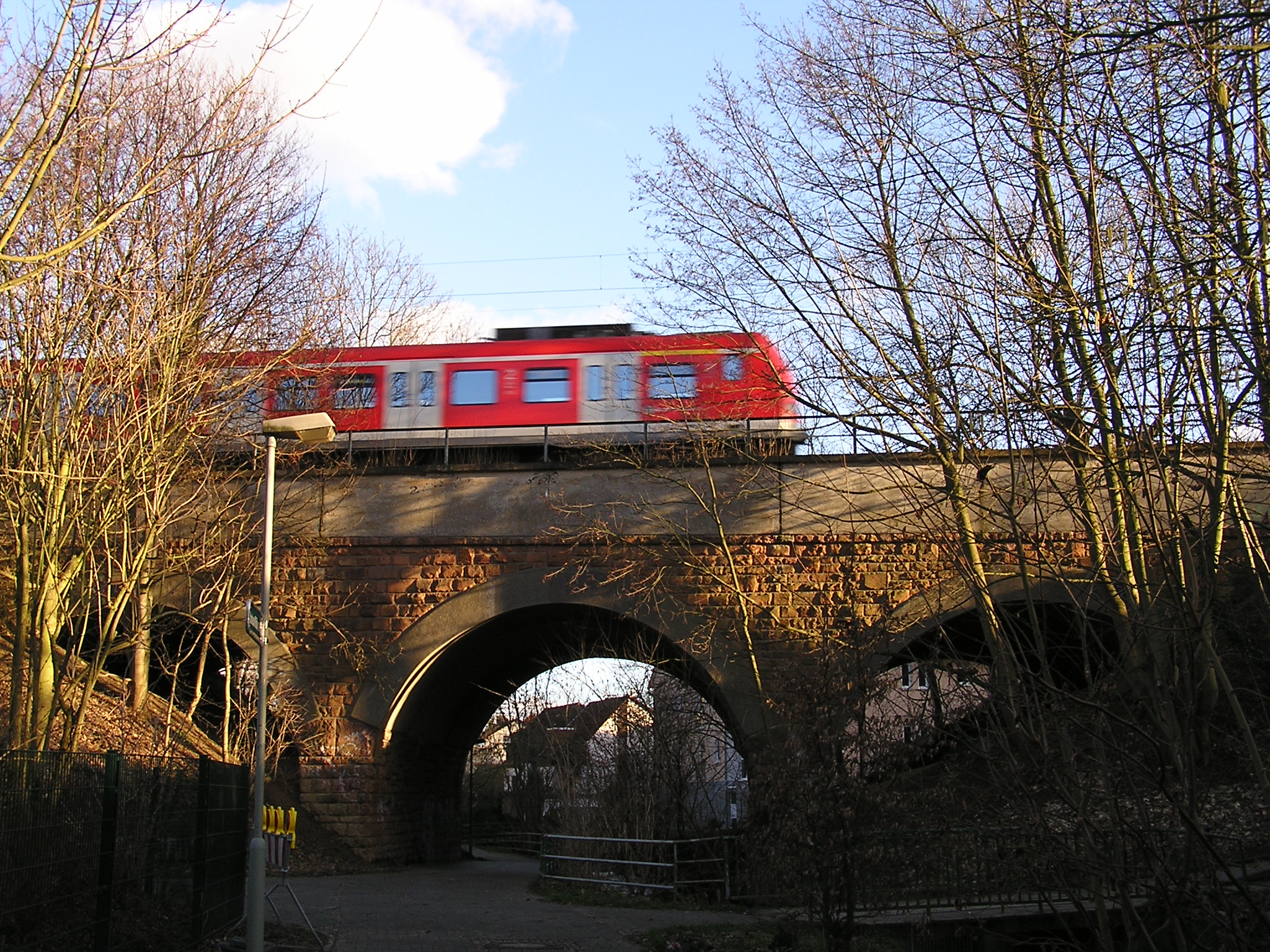Homburg Railway on:
[Wikipedia]
[Google]
[Amazon]
The Homburg Railway (german: Homburger Bahn ) is an 18 km line from
 The
The
 In 1895, the Usingen line from Homburg via
In 1895, the Usingen line from Homburg via
 The Homburg line is now used by S-Bahn S5 services between Frankfurt South and
The Homburg line is now used by S-Bahn S5 services between Frankfurt South and
Frankfurt am Main
Frankfurt, officially Frankfurt am Main (; Hessian: , "Frank ford on the Main"), is the most populous city in the German state of Hesse. Its 791,000 inhabitants as of 2022 make it the fifth-most populous city in Germany. Located on its na ...
to Bad Homburg
Bad Homburg vor der Höhe () is the district town of the Hochtaunuskreis, Hesse, on the southern slope of the Taunus mountains. Bad Homburg is part of the Frankfurt Rhein-Main Regional Authority, Frankfurt Rhein-Main urban area. The town's offic ...
in the German state of Hesse
Hesse (, , ) or Hessia (, ; german: Hessen ), officially the State of Hessen (german: links=no, Land Hessen), is a States of Germany, state in Germany. Its capital city is Wiesbaden, and the largest urban area is Frankfurt. Two other major histor ...
. It was opened in 1860 as one of the first railway lines in Germany. It is now part of the Rhine-Main S-Bahn line S5 to Friedrichsdorf
Friedrichsdorf () is a town of the Hochtaunuskreis, some north of Frankfurt am Main in Hesse, Germany.
Geography
Location
Friedrichsdorf is located in the Taunus area, ranking third among the Hochtaunuskreis boroughs after Bad Homburg vor der ...
.
History
Early on, there was support in Homburg for an efficient transport connection from Frankfurt in order to increase patronage to its spa and casino. In 1850 a horse-drawn omnibus provided an hourly service from Frankfurt to Homburg, but this soon was not enough to meet the needs of travellers. Projects to build railways failed in 1836, 1845, 1851 and 1856, caused by funding problems and the number of small states that the line would have to run through: the line as built was only 18 km long but it ran across the territories of four independent countries: theFree City of Frankfurt
For almost five centuries, the German city of Frankfurt was a city-state within two major Germanic entities:
*The Holy Roman Empire as the Free Imperial City of Frankfurt () (until 1806)
*The German Confederation as the Free City of Frankfurt ...
, the Grand Duchy of Hesse
The Grand Duchy of Hesse and by Rhine (german: link=no, Großherzogtum Hessen und bei Rhein) was a grand duchy in western Germany that existed from 1806 to 1918. The Grand Duchy originally formed from the Landgraviate of Hesse-Darmstadt in 1806 ...
(Darmstadt), the Duchy of Nassau
The Duchy of Nassau (German: ''Herzogtum Nassau'') was an independent state between 1806 and 1866, located in what is now the German states of Rhineland-Palatinate and Hesse. It was a member of the Confederation of the Rhine and later of the G ...
and the Landgraviate of Hesse-Homburg
Hesse-Homburg was formed into a separate landgraviate in 1622 by the landgrave of Hesse-Darmstadt; it was to be ruled by his son, although it did not become independent of Hesse-Darmstadt until 1668. It was briefly divided into Hesse-Homburg and ...
. Nassau had concerns because it would increase competition with its own spas. The Electorate of Hesse-Kassel
The Electorate of Hesse (german: Kurfürstentum Hessen), also known as Hesse-Kassel or Kurhessen, was a landgraviate whose prince was given the right to elect the Emperor by Napoleon. When the Holy Roman Empire was abolished in 1806, its prin ...
's opposition forced the line to avoid Bockenheim, which was in Hesse-Kassel territory on the Main-Weser Railway, just outside Frankfurt. The locals called the line with some exaggeration the "six nation railway".
When, after tough negotiations, at the end of June 1859 an acceptable route was found and the Homburg casino agreed to finance it, all countries concerned granted a concession to the British railway entrepreneur, Sir Samuel Morton Peto
Sir Samuel Morton Peto, 1st Baronet (4 August 1809 – 13 November 1889) was an English entrepreneur, civil engineer and railway developer, and, for more than 20 years, a Member of Parliament (MP). A partner in the firm of Grissell and Peto, he ...
and the ''Homburg Railway Company'' (''Homburger Eisenbahn-Gesellschaft'', HEG) was founded. Construction under the direction of the famous railway engineer Edmund Heusinger von Waldegg
Edmund Heusinger von Waldegg (12 May 1817 – 2 February 1886) was a German mechanical engineer and railway engineer.
Edmund Heusinger was born in Langenschwalbach (present day Bad Schwalbach) in the state of Hesse in central Germany on 12 May 1 ...
was carried out very quickly and on 10 September 1860 the first passenger trains ran, the first goods train on 6 October 1860. In Frankfurt it connected with the Main-Weser station (''Main-Weser-Bahnhof'') on the Gallusanlage (a section of the old Frankfurt wall), and ran along the Taunus Railway
The Taunus Railway (German: ''Taunus-Eisenbahn'') is a double-track electrified railway line, which connects Frankfurt and Wiesbaden, Germany. It is 41.2 km long and follows the course of the Main on its north side, running quite close ...
to the old vineyards (''Rebstockgelände'') west of Frankfurt, where it branched off to Rödelheim. It then went ran via Weisskirchen and Oberursel to Homburg, where it ended at a terminal station in Louisenstraße.
At its opening it had 28 first to third class carriages and luggage and freight wagons and four locomotives with a 1B wheel arrangement
In rail transport, a wheel arrangement or wheel configuration is a system of classifying the way in which wheels are distributed under a locomotive. Several notations exist to describe the wheel assemblies of a locomotive by type, position, and c ...
, supplied by Henschel
Henschel & Son (german: Henschel und Sohn) was a German company, located in Kassel, best known during the 20th century as a maker of transportation equipment, including locomotives, trucks, buses and trolleybuses, and armoured fighting vehicle ...
with works numbers 46 to 49. In 1870, a similar locomotive was procured from Henschel with the works number 290. The number of carriages had been increased to 36. Initially eight pairs of trains ran daily.
Further development
 The
The Prussia
Prussia, , Old Prussian: ''Prūsa'' or ''Prūsija'' was a German state on the southeast coast of the Baltic Sea. It formed the German Empire under Prussian rule when it united the German states in 1871. It was ''de facto'' dissolved by an em ...
n annexations after the War of 1866
The Austro-Prussian War, also by many variant names such as Seven Weeks' War, German Civil War, Brothers War or Fraternal War, known in Germany as ("German War"), (; "German war of brothers") and by a variety of other names, was fought in 186 ...
simplified the situation for the railway. The whole route now ran through Prussia, except for one small piece at Weißkirchen station. The closing of the casino by the Prussian state in 1872 led to a significant fall in passenger numbers. In 1873 and 1874 the Kronberg Railway
The Kronberg Railway (german: Kronberger Bahn) is now the northern part of Rhine-Main S-Bahn, Frankfurt S-Bahn S4 (Rhine-Main S-Bahn), line S4, which connects Langen, Hesse, Langen, Frankfurt am Main and Kronberg im Taunusin Hesse, Germany. The rou ...
was built by a private railway company: it branched off after Rödelheim to Kronberg.
On 1 January 1880 the railway was sold to Prussia because the company could not afford and did not want the changes to the line required for connection to the planned new Frankfurt Hauptbahnhof
Frankfurt (Main) Hauptbahnhof, also called Frankfurt Central Station and Frankfurt Main Station, is the busiest railway station in the German state of Hesse. Because of its location near the middle of Germany and usage as a transport hub for lo ...
. It thus became part of the Prussian state railways
The term Prussian state railways (German: ''Preußische Staatseisenbahnen'') encompasses those railway organisations that were owned or managed by the State of Prussia. The words "state railways" are not capitalized because Prussia did not have a ...
. The line was diverted to connect at Bockenheim station (now Frankfurt West), which had to be avoided in 1860, on the also nationalised Main-Weser Railway. The diversion, opened on 10 May 1884, shortened the line to 15.6 km from Frankfurt West. The old line through the vineyards was removed.
Extension and expansion
 In 1895, the Usingen line from Homburg via
In 1895, the Usingen line from Homburg via Friedrichsdorf
Friedrichsdorf () is a town of the Hochtaunuskreis, some north of Frankfurt am Main in Hesse, Germany.
Geography
Location
Friedrichsdorf is located in the Taunus area, ranking third among the Hochtaunuskreis boroughs after Bad Homburg vor der ...
to Usingen
Usingen is a small town in the Hochtaunuskreis in Hessen, Germany. Until 1972, this residential and school town was the seat of the former district of Usingen.
Coat of arms
The earliest seal whose appearance is known – there had been earlier on ...
was opened and some years later extended to Weilburg
Weilburg is, with just under 13,000 inhabitants, the third biggest town in Limburg-Weilburg district in Hesse, Germany, after Limburg an der Lahn and Bad Camberg.
Geography
Location
The community lies in the Lahn valley between the Wester ...
and Wetzlar
Wetzlar () is a city in the state of Hesse, Germany. It is the twelfth largest city in Hesse with currently 55,371 inhabitants at the beginning of 2019 (including second homes). As an important cultural, industrial and commercial center, the un ...
on the Lahntal railway
The Lahntal railway (German: ''Lahntalbahn'') is a railway line between Niederlahnstein in the German state of Rhineland-Palatinate to Wetzlar in Hesse. Its western terminus was originally in Oberlahnstein. Trains now mostly operate between Kob ...
. In Homburg a second terminal station (''Homburg Neu'', new Homburg) was built in Louisenstraße, 200 to 300 metres from the first station, on the site of the current town hall. A link line between the two stations enabled shunting. Planning of a line to Friedberg began in 1868, although construction did not start until 1898 and the line was commissioned on 15 July 1901. It branched off the line to Usingen in Friedrichsdorf.
In 1907, the old Homburg stations were replaced with the current station, creating a through line to Friedrichsdorf. In 1912, Homburg was renamed Bad Homburg. Between 1907 and 1912 the entire route from Frankfurt to Friedrichsdorf and Friedberg was duplicated.
Connecting curves
On 1 September 1905, a link was opened at the request ofEmperor Wilhelm II
Wilhelm II (Friedrich Wilhelm Viktor Albert; 27 January 18594 June 1941) was the last German Emperor (german: Kaiser) and King of Prussia, reigning from 15 June 1888 until his abdication on 9 November 1918. Despite strengthening the German Empi ...
through the Frankfurt vineyards (''Rebstockgelände''), initially only for freight and special trains. It branched off the Homburg line south of Rödelheim towards Höchst and was used from 1908 by passenger trains on the Bad Nauheim–Wiesbaden line (''Bäderbahn'', ''Spa Railway'') between the spa
A spa is a location where mineral-rich spring water (and sometimes seawater) is used to give medicinal baths. Spa towns or spa resorts (including hot springs resorts) typically offer various health treatments, which are also known as balneoth ...
(German: ''Bad'') towns of Wiesbaden
Wiesbaden () is a city in central western Germany and the capital of the state of Hesse. , it had 290,955 inhabitants, plus approximately 21,000 United States citizens (mostly associated with the United States Army). The Wiesbaden urban area ...
, Bad Homburg and Bad Nauheim
Bad Nauheim is a town in the Wetteraukreis district of Hesse state of Germany.
As of 2020, Bad Nauheim has a population of 32,493. The town is approximately north of Frankfurt am Main, on the east edge of the Taunus mountain range. It is a wor ...
. A link between this line and Frankfurt Hauptbahnhof was opened on 15 March 1927 and is still used by trains connecting to the Taunusbahn to the north of Bad Homburg. The curve from Homburg to Höchst was demolished in 1963 during motorway
A controlled-access highway is a type of highway that has been designed for high-speed vehicular traffic, with all traffic flow—ingress and egress—regulated. Common English terms are freeway, motorway and expressway. Other similar terms i ...
construction.
After 1945
After repairs to war damage the line recovered its importance for handling commuter traffic to Frankfurt. On 23 May 1954 a regular interval half-hourly timetable was introduced, initially hauled by class 78 steam locomotives and class V 80 and later V 100 diesel locomotives. The extension to Friedberg was downgraded to a single-track branch line due to war damage and a loss of profitability. Following the completion of electrification on 26 September 1970 services were usually operated by trains hauled by class 141 electric locomotives. From 25 September 1977S-Bahn
The S-Bahn is the name of hybrid urban- suburban rail systems serving a metropolitan region in German-speaking countries. Some of the larger S-Bahn systems provide service similar to rapid transit systems, while smaller ones often resemble co ...
services were operated by electric multiple units
An electric multiple unit or EMU is a multiple-unit train consisting of self-propelled carriages using electricity as the motive power. An EMU requires no separate locomotive, as electric traction motors are incorporated within one or a number ...
of class 420 terminating in Friedrichsdorf. Since 2003 the newer class 423 trains have operated on the line.
Operations
 The Homburg line is now used by S-Bahn S5 services between Frankfurt South and
The Homburg line is now used by S-Bahn S5 services between Frankfurt South and Friedrichsdorf
Friedrichsdorf () is a town of the Hochtaunuskreis, some north of Frankfurt am Main
Frankfurt, officially Frankfurt am Main (; Hessian: , "Frank ford on the Main"), is the most populous city in the German state of Hesse. Its 791,000 inh ...
, and Hessische Landesbahn
Hessische Landesbahn (Hessian State Railway, HLB) is a regional transport company owned by the German state of Hesse, based in Frankfurt am Main. It provides bus and rail passenger transport services and, to a lesser extent, rail freight services i ...
RB 15 services on the Taunusbahn between Frankfurt and Friedrichsdorf and Brandoberndorf. S-Bahn line S3 (Darmstadt
Darmstadt () is a city in the States of Germany, state of Hesse in Germany, located in the southern part of the Frankfurt Rhine Main Area, Rhine-Main-Area (Frankfurt Metropolitan Region). Darmstadt has around 160,000 inhabitants, making it th ...
–Bad Soden
Bad Soden (; also: ''Bad Soden am Taunus'') is a town and spa in the Main-Taunus-Kreis, Hessen, Germany. It had a population of 22,563 , up from 21,412 in 2005.
Information
Bad Soden is a residential town for commuters working in Frankfurt am ...
) and line S4 (Darmstadt/ Langen–Kronberg im Taunus
Kronberg im Taunus is a town in the Hochtaunuskreis district, Hesse, Germany and part of the Frankfurt Rhein-Main Regional Authority, Frankfurt Rhein-Main urban area. Before 1866, it was in the Duchy of Nassau; in that year the whole Duchy was ab ...
) use the section of the Homburg line from the City Tunnel City Tunnell may refer to:
* City Tunnel (Malmö), a railway tunnel in Sweden
* Cross City Tunnel, a road tunnel in Sydney, Australia
* Frankfurt City Tunnel, a railway tunnel in Germany
* Offenbach City Tunnel, a railway tunnel in Germany
* Leipzi ...
to Rödelheim. Line S6 uses Homburg line tracks as far as Frankfurt West instead of the parallel Main-Weser line. The Homburg line is integrated in the Rhein-Main-Verkehrsverbund
The Rhein-Main-Verkehrsverbund (RMV) is a transport association that covers the public transport network of the Frankfurt Rhine-Main area in Germany. Its head office is located in Hofheim im Taunus.
Organisation and area covered
The RMV ...
(RMV) transport network.
Future
It is planned to extend line U2 of theFrankfurt U-Bahn
The Frankfurt U-Bahn is a Stadtbahn system serving Frankfurt, Hesse, Germany. Together with the Rhine-Main S-Bahn and the Frankfurt Straßenbahn, it forms the backbone of the public transport system in Frankfurt. Its name derives from the Germa ...
from Bad Homburg-Gonzenheim to Homburg station.
A project known as ''Regionaltangente West'' (''Regional Tangent West'') would build a north–south line through Frankfurt Airport Regional station
Frankfurt (Main) Airport regional station (german: Frankfurt (Main) Flughafen Regionalbahnhof) is an underground railway station at Frankfurt Airport in Frankfurt, Germany. It provides local S-Bahn and '' Regionalbahn'' services to the city and t ...
and could connect with the Bad Homburg line.
References
{{Navbox Rhine-Main S-Bahn Railway lines in Hesse Transport in Frankfurt Rhine-Main S-Bahn 1860 establishments in Germany Railway lines opened in 1860 Taunus Buildings and structures in Hochtaunuskreis